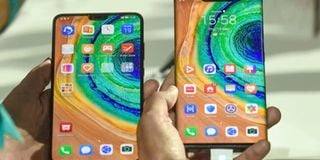Only high end phones will have access to Safaricom’s 5G network

Huawei Mate 30 Pro smartphone by Chinese tech giant Huawei.
What you need to know:
- Safaricom’s stand-alone 5G connectivity will require users to dig deeper into their pockets.
- It is expected that 5G phone manufactures will turn their focus to Kenya in a bid to feed a thirsty tech-savvy market.
After a series of tests in the past one year, Safaricom has officially launched its standalone 5G network Friday, making Kenya the first country in eastern Africa to adopt the technology regarded as a key enabler of the Fourth Industrial Revolution (4IR).
However, to enjoy the super-fast speed where you can download a 3-Gigabyte movie in seconds, you will need a high end phone that has the 5G chip, rendering most smartphones owned by Kenyans incompatible.
Contrary to non-stand-alone (NSA) 5G networks that upgrade on existing 4G LTE (Long Term Evolution) networks, Safaricom’s stand-alone 5G connectivity will require you to dig deeper into your pockets to, for instance, afford the Huawei Mate 30 Pro which retails at Sh70,000 or the Huawei P40 which goes for Sh98,000, if you want to switch to 5G as early as today.
While the service is enabled on the Nokia 8.3, Samsung Galaxy S21 5G series, Samsung Galaxy Note 20 series and the Samsung Galaxy Z Fold2, you will have to wait till the beginning of May to join the network of the future. It will take the two phone makers one month to update their smartphone software to match 5G requirements.
Such devices are only owned by a very small percentage of the Kenyan population, with a February report released by British research firm Caribou Data indicating that 94 per cent of Kenyans own phones costing less than Sh20,000.
But with the 5G technology now in existence, it is expected that 5G phone manufactures will turn their focus to Kenya in a bid to feed a thirsty tech-savvy market that requires more affordable 5G devices.
Super-fast internet
During a press event held at the Michael Joseph Centre on Friday in Westlands, Nairobi, the company said 5G trials will begin with both individual and enterprise customers in the city. The service will also be extended to the western counties of Kisumu, Kisii and Kakamega.
Safaricom’s 5G speed will be 700 Megabits per second (Mbps), with plans to offer more than 1,000 Mbps speeds towards the end of the year, immensely improving on the current 4G speed that averages 15Mbps this year.
Peter Ndegwa, the telco’s chief executive, said the launch was timely as it comes during a pandemic period which has pushed thousands of Kenyans and businesses to cloud-based services and Internet of Things (IoT).
“With 5G, we aim to empower our customers with super-fast internet at work, at home and when on the move, supplementing our growing fibre network,” he said.
Partnering with global 5G service providers Huawei and Nokia, Safaricom said it will have laid 150 stand-alone 5G base stations across nine towns by March next year.
For enterprise and Safaricom home internet customers, new 5G routers will be issued across the covered zones as the technology now becomes an alternative to fixed home and office internet.
3G network reach
Mr Ndegwa said that Safaricom invests Sh35 billion annually on network infrastructure expansion and that has seen the company’s 3G network reach 94 per cent of its subscribers while 92 per cent of Kenyans enjoy 4G speeds.
“This will enable deployment of advanced digital technologies such as Virtual Reality, cloud computing, autonomous drones, industrial automation and a wide range of IoT uses.”
5G modems from Huawei will be able to convert 5G signal to Wi-Fi for your non 5G devices, with only the Safaricom upgraded sim card being needed.
ICT Cabinet Secretary Joe Mucheru said the super-fast network could potentially spur Kenya’s startup culture, creating a new generation of innovators.
“5G technology will usher in increased internet speeds and capabilities for millions across the country,” he said.
5G, which powers intelligent connectivity, can support up to 1 million connected devices per square kilometre compared to the current 4G whose maximum capacity is 100,000 connected devices for the same zone.





